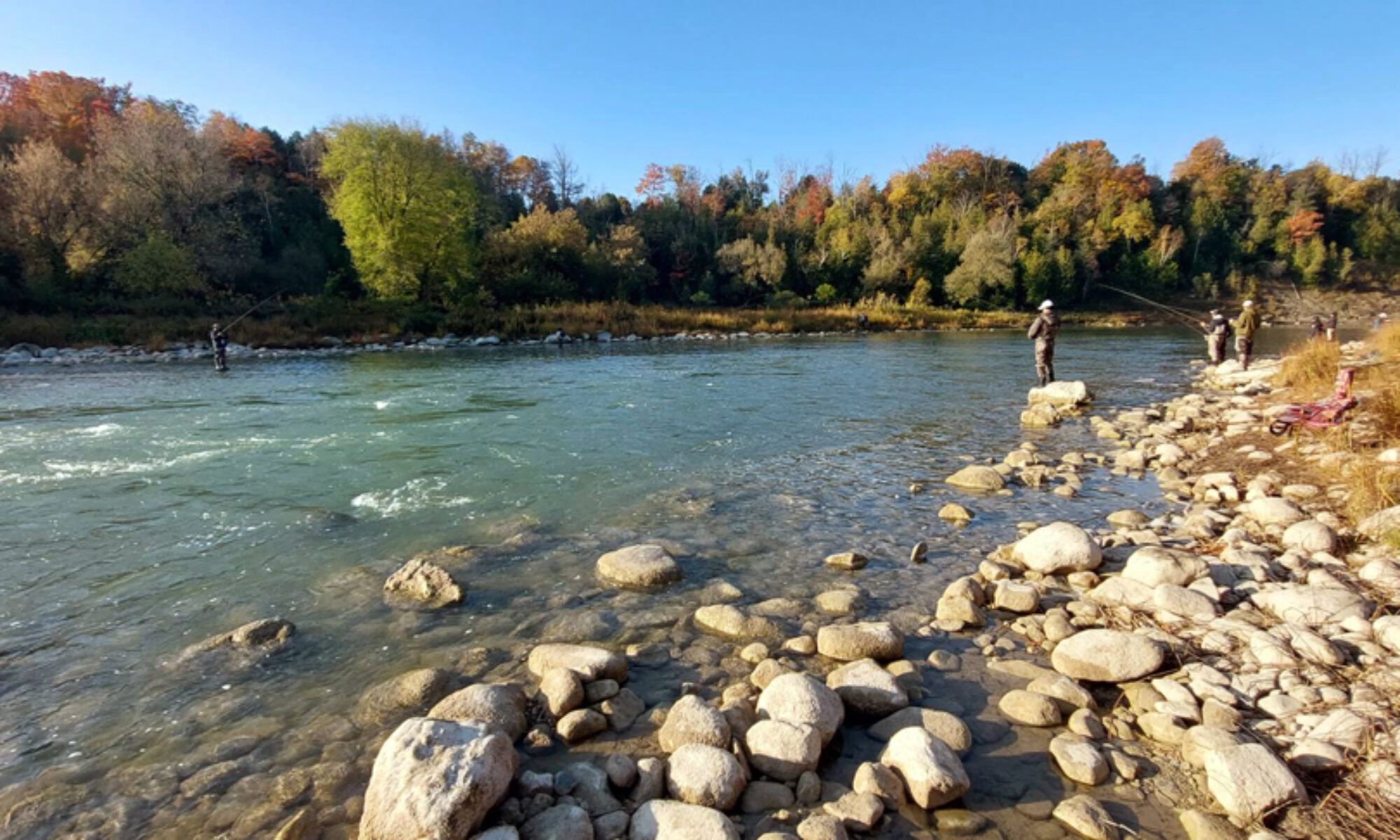…as it is to be situated near Many Headwaters Producing Steelhead in Ontario!
What is expected to be the second largest aggregate quarry in North America is to be located in Melancthon Township. The Highlands Companies is seeking permission to open a 2,300 acre (937 hectare) quarry just north of Shelburne. The company wants to mine up to 1.102 billion tons (I billion tonnes) of a high quality limestone called Amabel dolostone. This proposed quarry will sit on the Amabel-Lockport-Guelph aquifer. The proposed mega quarry is to be situated near the headwaters of many Ontario rivers – Pine, Noisy, Nottawasaga, Boyne, Mad, Saugeen and Grand Rivers. The proposed pit will be 200 feet (60 metres) in depth which is well below the water table in this area. The quarry operators will be required to pump an estimated 131.98 million gallons (600 million litres) of water from the pit each day. To put this figure into perspective, that is the equivalent of the amount of water used by 2.7 million Ontarians per day! This is the estimated amount of water that would seep into the pit since the pit will be below the water table. The company has said it will pump the water back into the aquifer. The concern is – in what condition!
Melancthon Township is located within Dufferin County. This county is the highest plateau immediately west of Georgian Bay. Because of the county’s geographic location and topography, the county forms the watershed for Lakes Huron, Simcoe, Ontario and Erie. Also the Nottawasaga, Saugeen, Grand and Credit Rivers commence here and then each system drains throughout the county. This area is one of the largest catchment areas in southwestern Ontario. This is a very important landscape in Ontario.
The Highlands Companies is made up of several numbered companies, set up in Nova Scotia. This was done as the province of Nova Scotia offers tax breaks for American investors. The company has purchased approximately 6,500 acres (2,630 hectares) in total. Most of this land is in Melancthon Township – 5,600 acres (2,266 hectares). The balance, 900 acres (364 hectares) lies in Mulmur Township. Currently the Highlands Companies grow and harvests 100 million pounds (45.4 million kilograms) of potatoes annually.
Under The Environmental Bill of Rights, EBR Registry Number 011-2864, the proponent 3191574 Nova Scotia Company applied for a Class “A” Licence Quarry Below Water to excavate more than 20,000 tonnes of aggregate annually. The Highlands Companies have proposed it will mine over 50 to 100 years excavating in sections of 300 acres (121 hectares) at a time. The section would be returned to farmland by “re-laying” soil after the mining process is completed.
The Highlands Company has filed twenty consultant reports totaling 3,100 pages. The consultants assert that the proposed project will have no negative impacts on fish habitat and will allow for improvement in the diversity, connectivity and function of the natural heritage systems in the area including linkages between natural heritage features, surface water features and groundwater features and long term increase in the quality and diversity of wildlife habitat associated with the agricultural landscape (see Page 10.2 – Net Impacts).
Many areas of the Stantec report leave one pondering their conclusions. There is certainly a lack of information in regards to the consultant’s “Fish Habitat Assessment”. In the spring, summer and fall of 2008, as well as the summer of 2009, “Aquatic Field Studies were carried out in the study area. The report fails to provide much detail in regards to the type of studies completed as well as when and where these studies were conducted. The studies carried out on the main stem of the Pine River, a tributary of the Nottawasaga River, are very troublesome.
One of the confusing items in the Stantec report is in regards to the assessment of the value of the Pine River Headwaters Wetland Complex. The Stantec report states that background fish community data from the Nottawasaga valley Conservation Authority’s (NVCA) 2007 Pine River Sub Watershed Report Card shows the Headwater Wetland Complex supports warm water baitfish only. This is not the case. In fact the report card does not refer to “warm” or “baitfish”. The NVCA report does state, “groundwater discharge from other wetlands – such as the Pine River headwaters – maintains cold stream flows that support trout”. A further document, NVCA Groundwater Management Plan (DRAFT) Version 5, dated November 3, 2009, says, “These headwater areas generally support a significant groundwater recharge/discharge cycle and supports coldwater fisheries habitats supporting native brook trout”.
The Ontario Ministry of the Environment also has some concerns with the reports prepared for the Highlands Companies. On September 1, 2011 the proponent, 3191574 Nova Scotia Company, is regulated to undergo an Environmental Assessment (EA) under the Environmental Assessment Act for the project. Mega-quarries do not require an EA in the province of Ontario. So this is a huge step. The first step will be to prepare the Terms of Reference (ToR) for the EA. Both the ToR and the EA will involve government review and a public consultation process. Once fisheries issues are raised, this could also involve the federal government’s review as well, as fisheries falls under federal jurisdiction. The process could take several years to resolve.
Issues surrounding water management, environmental damage, the degradation of groundwater and transportation are also serious concerns of this proposed quarry development. The truck traffic will greatly increase. The Highlands Company proposes to finance road improvements if its requirements exceed 150 40-tonne trucks per hour, 24 hours a day, every day except statutory holidays. That is 3,600 40 tonne trucks per day. That is staggering! As well, this quarry is proposed to operate for 50 to 100 years.
Another issue to be faced by the Highlands Company deals with some of the animals that could/are found in the area within the pit to be mined. There are indications of the presence of the Henslow’s Sparrow and the Bobolink. These species are included in either the provincial or federal Species at Risk Acts. For further information regarding the Highland Companies visit http://www.highlandcompanies.ca/ I did not discuss the impact on agriculture in this article. If you are interested in this, go to: http://highlandcompanies.ca/images/uploads/pdf/application/12_Agricultural_Impact_Assessment.pdf. This study was also prepared by Stantec.
There have been numerous township meetings held to discuss the proposed quarry. On October 16, 2011 “Foodstock” was held. This was organized by the Canadian Chef’s Congress. An estimated 28,000 people attended the one day event held on a farm near Shelbourne, Ontario. “Foodstock’ featured home-style food prepared by several of Ontario’s famous chefs along with entertainment provided by musical artists such as Ron Sexsmith, Susan Harmer and Jim Cuddy. The event was organized to raise public awareness in regards to the threat of southern Ontario’s agricultural lands, in this case, specifically the farms in Melancthon Township.
Many organizations are involved in protecting these valuable farm lands and rivers. These include, not only the Canadian Chefs’ Congress, but the Ontario Sierra Club, David Suzuki Foundation, Turtle Clan Mohawk Nation, Township of Melancthon, North Dufferin Agricultural Task Force, to name a few, as well as many, many residents.
As a wrap up, there are two processes in the works. The one is the Aggregate Resources Act (ARA). At this time, the Highland Companies must address the issues raised from this application process. The second is the Environmental Assessment Act. There are opportunities for you to voice your opinion. There are many developments and proposals that are going to impact on the state of the steelhead in the province of Ontario. Right now there is a subdivision proposal within the City of Brantford which could have a great impact on the natural steelhead population within the Grand River system. This area is a highly environmental sensitive area.
Please get involved throughout this province. You may not stop development, but you could have a positive influence on the many proposals and ultimately the environment in which migrating rainbow trout live in Ontario!

